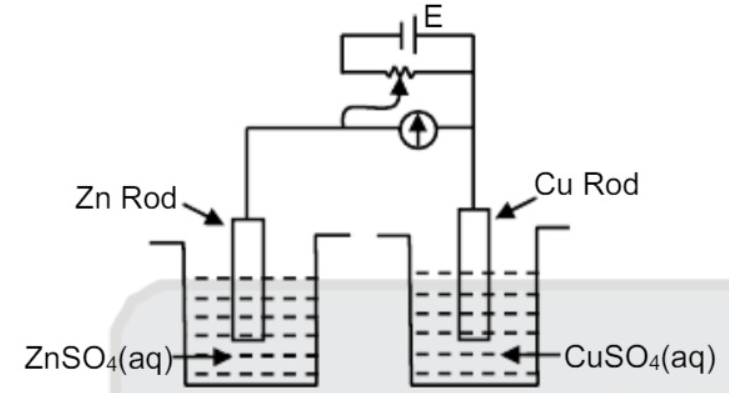A copper - silver cell is set up. The copper ion concentrations is 0.10 M. The concentration of silver ion is not known. The cell potential when measured was 0.422 V. Determine the concentration of silver ions in the cell.
Given E∘Ag+/Ag=+0.80V,E∘Cu2+/Cu=+0.34V
To determine the concentration of silver ions in a copper-silver cell, we can follow these steps:
Step 1: Write the half-reactions
In this electrochemical cell, we have the following half-reactions:
- Anode (oxidation):
Cu→Cu2++2e−
- Cathode (reduction):
Ag++e−→Ag
Since two electrons are involved in the overall reaction, we need to balance the number of electrons transferred. Thus, the balanced overall reaction is:
Cu+2Ag+→Cu2++2Ag
Step 2: Calculate the standard cell potential (E∘cell)
Using the standard reduction potentials provided:
- E∘Ag+/Ag=+0.80V
- E∘Cu2+/Cu=+0.34V
The standard cell potential is calculated as:
E∘cell=E∘cathode−E∘anode=0.80V−0.34V=0.46V
Step 3: Apply the Nernst equation
The Nernst equation relates the cell potential to the concentrations of the reactants and products:
Ecell=E∘cell−0.0591nlog((products)(reactants))
Where n is the number of moles of electrons transferred (which is 2 in this case).
Substituting the known values:
- Ecell=0.422V
- E∘cell=0.46V
- Concentration of Cu2+=0.10M
The equation becomes:
0.422=0.46−0.05912log(0.10(Ag+)2)
Step 4: Rearranging the equation
First, isolate the logarithmic term:
0.422−0.46=−0.05912log(0.10(Ag+)2)
−0.038=−0.05912log(0.10(Ag+)2)
Multiplying both sides by -1:
0.038=0.05912log(0.10(Ag+)2)
Step 5: Solve for (Ag+)
Now, multiply both sides by 20.0591:
0.038×20.0591=log(0.10(Ag+)2)
Calculating the left side:
0.0760.0591≈1.287
So,
1.287=log(0.10(Ag+)2)
Taking the antilogarithm:
0.10(Ag+)2=101.287
(Ag+)2=0.10101.287≈0.1019.2≈0.0052
(Ag+)≈√0.0052≈0.072M
Final Answer
The concentration of silver ions (Ag+) is approximately:
(Ag+)≈7.1×10−2M
In this electrochemical cell, we have the following half-reactions:
Cu→Cu2++2e−
Ag++e−→Ag
Cu+2Ag+→Cu2++2Ag
Using the standard reduction potentials provided:
- E∘Ag+/Ag=+0.80V
- E∘Cu2+/Cu=+0.34V
E∘cell=E∘cathode−E∘anode=0.80V−0.34V=0.46V
The Nernst equation relates the cell potential to the concentrations of the reactants and products:
Ecell=E∘cell−0.0591nlog((products)(reactants))
Where n is the number of moles of electrons transferred (which is 2 in this case).
- Ecell=0.422V
- E∘cell=0.46V
- Concentration of Cu2+=0.10M
0.422=0.46−0.05912log(0.10(Ag+)2)
First, isolate the logarithmic term:
0.422−0.46=−0.05912log(0.10(Ag+)2)
−0.038=−0.05912log(0.10(Ag+)2)
0.038=0.05912log(0.10(Ag+)2)
Now, multiply both sides by 20.0591:
0.038×20.0591=log(0.10(Ag+)2)
Calculating the left side:
0.0760.0591≈1.287
So,
1.287=log(0.10(Ag+)2)
0.10(Ag+)2=101.287
(Ag+)2=0.10101.287≈0.1019.2≈0.0052
(Ag+)≈√0.0052≈0.072M
The concentration of silver ions (Ag+) is approximately:
(Ag+)≈7.1×10−2M
Topper's Solved these Questions
- XII BOARDSBook:XII BOARD PREVIOUS YEAR PAPER ENGLISHChapter:XII BOARDSExercise:[SET-II]
Explore 10 Videos
- XII BOARDSBook:XII BOARD PREVIOUS YEAR PAPER ENGLISHChapter:XII BOARDSExercise:[SET-III]
Explore 10 Videos
- XII BOARDSBook:XII BOARD PREVIOUS YEAR PAPER ENGLISHChapter:XII BOARDSExercise:Delhi Board : Set - III
Explore 7 Videos
- SAMPLE PAPER 2019Book:XII BOARD PREVIOUS YEAR PAPER ENGLISHChapter:SAMPLE PAPER 2019Exercise:SECTION: D
Explore 1 Video
Similar Questions
A copper-silver cell is set up. The copper ion concentration in it is 0.10 M. The concentration of silver ions is not known.The cell potential measured is 0.422 V. Determine the concentration of silver ions in the cell. [Given E∘Ag+/Ag=0.80,E∘Cu2+/Cu=+0.34V]
View SolutionThe standard electrode potential of Cu∣Cu+2 is - 0.34 Volt. At what concentration of Cu+2 ions, will this electrode potential be zero?
View SolutionIf excess ofZn is added to 1.0M solution of CuSO4 , find the concentration of Cu2+ ions at equilibrium.
Given:Ec−.(Zn2+∣Zn)=−0.76V
Ec−.cell=(Ec−.(Cu2+∣Cu)=0.34V
View SolutionCalculate the emf of the given cell:
Cu/Cu2+(0.01M)∣∣Cu2+(0.001M)∣Cu is
(E∘Cu2+/Cu=+0.34V)
View SolutionFor the reduction of silver ions with copper metal, the standard cell potential was found to be +0.46V at 25∘C. The value of standard Gibbs energy, ΔG∘ will be (F=96,500Cmol−1):
View SolutionOne half-cell in a voltaic cell is constructed from a silver wire dipped in silver nitrate solution of unknown concentration . Its other half-cell consists of a zinc electrode dipping in 1.0M solution of Zn(NO3)2 . A voltage of 1.48 V is measured for this cell . Use this information to calculate the concentration of silver nitrate solution used. (E∘Zn2+∣Zn=−0.76V,E∘Ag+∣Ag=+0.80V).
View SolutionConsider the cell Zn∣∣Zn2+∣∣∣∣Cu2+∣∣Cu. If the concentration of Zn and Cu ions are doubled, the emf of the cell.
View SolutionFor the given cell arrangement identify incorrect statement
given E∘_(Cu2+/Cu) = 0.34V &E∘_(Zn2+/Zn)=−0.76V
View SolutionFor the reduction of silver ions with copper metal, the standard cell potential was foound to be +0.46V at 25∘C. The value of standard Gibbs energy, ΔG∘ will be (F=96,500Cmol−1):
View SolutionCalculate the maximum work that can be obtained from the decimolar Daniell cell at 25∘C.
Given Ec−.(Zn2+∣Zn)=−0.76V and Ec−.(Cu2+∣Cu)=0.34V
View Solution